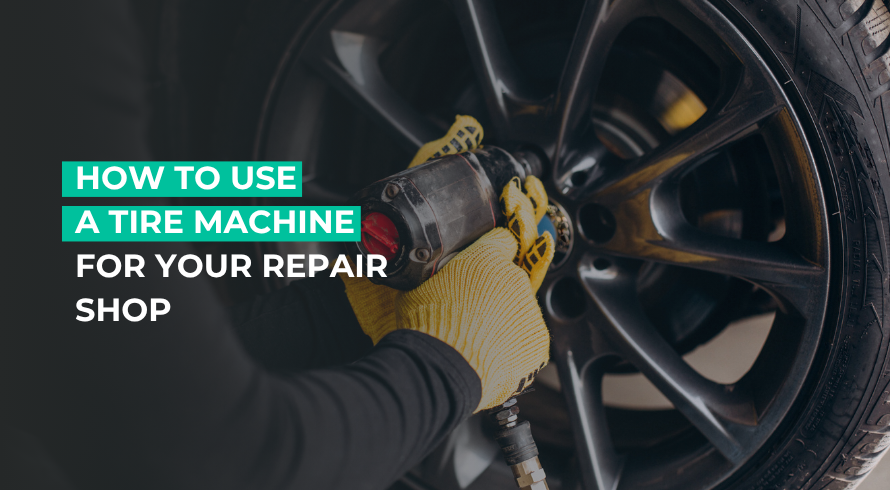What happens when your auto tech has to lift the tire and manually change it on the wheel? It requires a lot of physical effort and time. All this time and effort can be spent on other, more meaningful tasks around the auto shop or garage. A tire machine or a tire changer helps by taking away the physical effort involved in changing the tire. It also reduces the time spent on the job.
Tires are also very expensive. You don’t want any damage to the expensive wheels or tire rims. You also need to follow certain safety standards, and using a tire machine helps you mount/dismount tires safely. So then, how do you use a tire machine?
Whether you’re an experienced mechanic, a beginner automotive tech, or even a DIYer who is working on the vehicle in their backyard, you need to know the correct way to use a tire machine, as it will save you time and effort. Let’s take you through a few key areas in this blog
- How to use a tire machine
- Parts of the tire machine
- Safety protocols to follow
- How to mount/dismount a tire.
What does a tire machine do?
A tire machine helps auto techs dismount old tires from wheels and mount new ones on with precision, safety, and ease. A tire machine keeps the wheel in place and helps reduce the manual work involved. With precision and ease, a tire machine also protects the wheel or rim from any damage. Very simply, it is the main tool required for tire replacement and repair.
How would you select the right tire machine? Your shop needs one, whether you occasionally need it or you need it to manage a high volume of work.
There are a few types of tire machines. Let’s break down the different ones according to features and capabilities.
Types of tire machines
Manual tire changer
A manual tire changer is cost-effective. It might be a great fit for a smaller shop, with a low volume of work. As the name suggests, these require manual labor, and because of that, they will need more strength. It might also cause some damage to the tire or wheel. But, these have the ability to work with different tire sizes. Automated tire changers lack that capability.
Automated tire changer
An automated tire changer will cost a lot more than a simple, manual tire changer. But it helps you increase productivity by a wide margin. It also reduces the time spent changing tires. Plus, because the process is automated without any human effort required, it prevents damage to the tire or wheel. The upfront cost might be more, but it offers speed, precision, and the ability to take on high-volume work.
Now, let’s go over a few different tire machines according to their features.
Types of tire machines according to features
Leverless tire changer: This doesn’t need a traditional lever. This also reduces the risk of scratching alloy or tire rims. If your shop works with high-end vehicles or performance cars, then a leverless tire changer is a great option as it allows techs to handle tires with care, precision and safety.
Swing arm tire changer: If your shop doesn’t have a high volume of work, then this is a good option. It is a semi-automatic one that can handle standard tires.
Tilt back tires: As the name suggests, this tire machine has a mounting arm that tilts back. This feature helps the tire machine to work with larger tires. Plus it’s also a great tire machine to have when working in a high-volume setting.
Heavy-duty tire changer: These work well for heavy commercial and industrial tires. These tire changers can take on a high load since these are designed to work with trucks and buses. If your shop works with commercial vehicles, then this is a good investment.
Key components of a tire machine
The tire machine is made up of a few key features. Let’s go over each of them and how they help.
Turntable:
A turntable is a rotating platform. It is where you hold the wheel in place. The rotation helps change the tire easily. It allows slow, very controlled and precise movement as you mount and dismount tires.
Clamps:
The clamps hold he rim in place as the tires are rotated on the turntable.
Bead breaker:
The bead breaker helps separate the tire from the rim without damaging the wheel and tires.
Foot pedals:
The foot pedals help the tech control the clamps and the turntable.
Mounting/demounting arm: This mounting arm helps take the tire bead over the rim. Depending on the tire machine’s features, the arm will swing back or tilt to give more access for a smooth operation.
How to safely use the tire machine
At the end of the day, a tire machine can be hazardous to operate if your techs aren’t trained and don’t follow safety protocols. These are a few key safety tips to follow when using a tire machine that can prevent any accidents.
- Wear safety goggles to shield your eyes from any debris or dirt.
- Use gloves to protect your hands.
- Before you begin the tire-changing process, check the tire for any damages.
- When seating a bead, don’t exceed 40 PSI.
- Keep the surrounding areas and workplace clean and free of any obstructions.
- Follow the guidelines provided by he manufacturer.
- Check the TPMS sensor on the tires and move them aside to prevent any damage from the tire machine.
How to dismount a tire from a rim using a tire machine
There are a few key steps to follow when dismounting a tire. Whether you’re doing it manually or using an automated tire machine.
Of course, you have to read the manual, wear protective gloves and goggles, and learn the basics about the equipment. But apart from that, here’s how you can dismount a tire from a rim:
- Clean the tire and rim to remove any dirt or debris.
- Deflate the tire using a valve core removal tool.
- Position the tire on the machine and then use the bead-breaking arm to remove the tire bead from the rim.
- Secure the wheel with a clamp on the turntable.
- Lower the bead breaker and rotate the turntable to dismount the tire without damaging the rim.
How to mount a tire on a rim with a machine
Once a tire is dismounted, you move on to the next part. That is mounting a new tire. Here’s what you’ll do:
- Rotate the TPMS sensor away from the mount/demount head.
- Lubricate both beads of the tire and the rim edges for ease.
- Position the tire’s lower bead on the mount demount head and then onto the rim.
- Next, set the tire’s upper bead on the mount demount head.
- Make sure the tire is seated evenly to avoid any air leaks.
- Inflate the tire as recommended by the manufacturer, not exceeding 40 PSI.
Common issues when using a tire machine
Your auto technicians might come across a few common challenges when using a tire changer. Whether they are experienced or they are new to the field. Here are a few common ones, and solutions to manage them:
- The bead can’t get seated easily
If the bead doesn’t seat easily, use more lubricant. Also, try to reposition the drop center. After this, try again.
- Low-profile or run-flat tires could have stiff sidewalls
If the low-profile or run-flat tires have stuff sidewalls, use your tire machine’s assist arm. That should help it.
- Expensive alloy wheels can get scratched
Solution: Use plastic protectors on clamps and duckheads
- The TPMS sensor can get damaged
Solution: always check for the TPMS sensor and rotate it 180 degrees away from the mounting head.
Now it’s not just about using the tire machine to improve your shop’s productivity. You also need to think about the shop’s overall efficiency and implement systems that go beyond the shop floor. This is where a tire shop management software comes in. It is a great tool to help you manage your shop’s workflow.
Use a tire management software
To further improve the efficiency of your auto shop, integrate a tire shop management software. This can help your auto shop:
- Save time by managing the tire inventory.
- Use digital vehicle inspections to help upsell tire replacements.
- Send quotes to customers faster and get approvals digitally.
- Issue invoices without any hassle.
When you put together physical efficiency (getting and using a tire machine) along with digital efficiency (using a tire shop software), you can save time, reduce human error, and ultimately provide excellent customer service.
Wrapping up
Using a tire machine is a very simple procedure once you have the basics right. Make sure to take all safety precautions and use all the proper techniques as recommended by the manufacturer. A tire machine, along with other tire shop equipment, can help you speed up processes in your auto shop. Your auto techs won’t have to spend extra time and energy mounting and dismounting tires manually.
Go a step further, streamline the whole process by onboarding a tire shop software to optimize the service processes further.
FAQs
How to use a tire inflator machine?
Check the tire pressure. Attach the hose to the valve using the tire pressure gauge. Press the lever. Turn the inflator on, and you will hear the air flowing through.
What are the three measurements you must enter in the tire balancing machine?
The three measurements needed in the tire balancing machine are the rim width, the diameter of the wheel, distance from the mounting plate to the inner edge of the wheel.
Are manual tire changes easy to use?
Manual tire changers are not easy to use as compared to automated tire changers, as they require a lot more physical effort.








